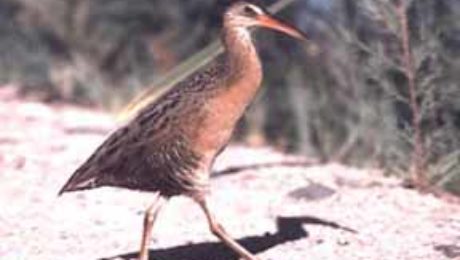Marshbird Survey Training Workshop
Project Description The U.S. Fish and Wildlife Service (USFWS) coordinates an annual region-wide multi-agency marsh bird survey effort throughout the Lower Colorado River valley region (AZ, CA, NV, and Mexico). This survey effort has occurred annually since 1978 and provides the data needed to assess the status of the endangered Yuma Clapper Rail. In 2006,
- Published in Awards Program
Expansion of the Little Greenhouse Project
Project Description The U.S. Fish and Wildlife Service has cooperated with other agencies such as the Bureau of Land Management and the Bureau of Reclamation in the planting of native cottonwood and willow poles on Havasu National Wildlife Refuge on the lower Colorado River. The Refuge has a nursery of cottonwood and willow trees which
- Published in Awards Program
Effects of the Ryan Wildfire on wintering grassland birds and winter grassland structure and composition in southeastern Arizona
Project Description On 29 April 2002, the Ryan wildfire swept through 38,000 acres of the Sonoita Valley in southeastern Arizona. This fire offers a valuable opportunity to conduct post-fire research to determine the effects of such a substantial wildfire on wintering grassland birds and the structure and composition of the grasslands on which they rely.
- Published in Awards Program
Habitat protection of a long-term study site in the tropical deciduous forest of Sonora, Mexico
Project Description Presently not much is known about the structure, dynamics, and fauna of the tropical deciduous forest. Relatively easy access and recent botanical surveys of the tropical deciduous forest around Alamos, Sonora provide an opportunity to consolidate ecological knowledge and cultivate interest among scientists and naturalists. In addition, the recovery from disturbance and response
- Published in Awards Program
Avian Monitoring in the Colorado River delta, Mexico
Project Description The Colorado River delta supports over 300,000 wintering waterbirds and is a critical stopover site for over 100 species of Neotropical migratory landbirds. This wetland system also provides habitat for significant populations of endangered species, such as the Yuma Clapper Rail and the California Black Rail. The goal of this project is to
- Published in Awards Program
Brochure printing and local guide training to enhance the quality of birding experience in the Santa Cruz and San Pedro Rivers
Project Description This project will promote environmental and economic stability in the Santa Cruz watershed by implementing conservation strategies that address both ecological and community issues. In 2000 the Sonoran Institute established the Community Conservation Center (CCC) of the Santa Cruz River in San Lázaro, Sonora. The CCC functions as a field station and community
- Published in Awards Program
Arizona’s Important Bird Areas Program: sites inventory component
Project Description Tucson Audubon Society (TAS) leads the Important Bird Area Program (IBA) for the state of Arizona. This program works with Audubon chapters, agency biologists, university scientists, regional non-profits, and citizens to provide a statewide inventory of sites critical to birds of conservation concern, sites where birds congregate in large numbers, or sites with
- Published in Awards Program
Arizona/Sonora bird migration monitoring network
Project Description This project is a coordinated series of six sites (three mountain and three lowland, four in Arizona and two in Sonora) selected to measure and monitor bird migration across a broad front of southeastern Arizona and northern Sonora through the use of constant effort mist netting. The six sites selected comprise a variety
- Published in Awards Program
Mapping the Possible: Products of the Conservation Priorities Workshop of the Colorado River Delta
Project Description The objective of this proposal is to develop and distribute the complete products of the Mapping Conservation Priorities of the Colorado River Delta Workshop. This binational workshop took place in Tijuana, Mexico on October 14-17, 2002. Working in interdisciplinary teams, participants had the opportunity to discuss the biophysical characteristics and ecological relationships of
- Published in Awards Program
Villa Verde restoration site monitoring, Sonora, Mexico
Project Description Much of the conservation work in the San Pedro Watershed of Arizona stops at the U.S. border, and areas located just a few miles south remain almost unknown. Villa Verde, a main tributary to the Upper San Pedro River, is located approximately 25 km southeast of the San Pedro Riparian National Conservation Area
- Published in Awards Program
- 1
- 2


 English
English  Español
Español 
